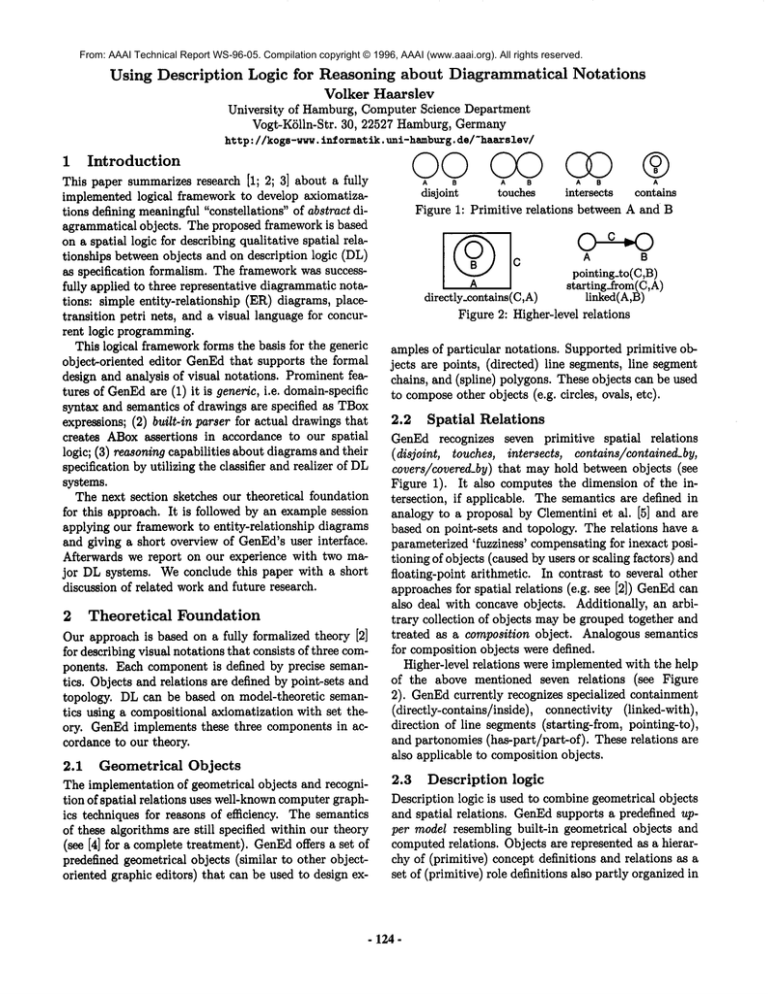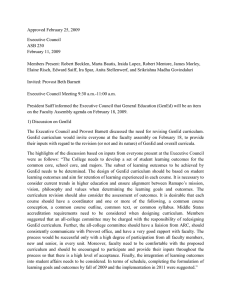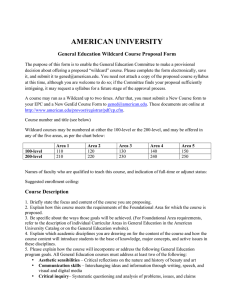
From: AAAI Technical Report WS-96-05. Compilation copyright © 1996, AAAI (www.aaai.org). All rights reserved.
Using Description
Logic for Reasoning about Diagrammatical Notations
Volker Haarslev
University of Hamburg, Computer Science Department
Vogt-KSlln-Str. 30, 2252? Hamburg, Germany
hl;tp://kogs-www.
InformatIk.unl-hamburg,
de/-haarslev/
1
OO QO (X}
Introduction
This paper summarizes research [1; 2; 3] about a fully
A
A
A
A
B
8
8
intersects
contains
disjoint
touches
implemented logical framework to develop axiomatizaFigure 1: Primitive relations between A and B
tions defining meaningful "constellations" of abstract diagrammatical objects. The proposed framework is based
on a spatial logic for describing qualitative spatial relationships between objects and on description logic (DL)
C
A
B
as specification formalism. The framework was successpointing_to(C,B)
A
starting_from(C,A)
fully applied to three representative diagrammatic notadirectly_contains(C,A)
linked(A,B)
tions: simple entity-relationship
(ER) diagrams, placeFigure
2: Higher-level
relations
transition petri nets, and a visual language for concurrent logic programming.
Thislogical
framework
formsthebasisforthegeneric amples of particular notations. Supported primitive obobject-oriented
editorGenEdthatsupports
theformal jects are points, (directed) line segments, line segment
designandanalysis
of visualnotations.
Prominent
fea- chains, and (spline) polygons. These objects can be used
turesofGenEdare(I)itis gener/c,
i.e.domain-specific
to composeother objects (e.g. circles, ovals, etc).
syntaxandsemantics
of drawings
arespecified
as TBox
2.2
Spatial Relations
expressions; (2) built-in parser for actual drawings that
creates ABoxassertions in accordance to our spatial
GenEd recognizes seven primitive spatial relations
logic; (3) reasoning capabilities about diagrams and their
(disjoint, touches, intersects, contains/contained_by,
specification by utilizing the classifier and realizer of DL covers/covered_by) that may hold between objects (see
systems.
Figure 1). It also computes the dimension of the inThe next section sketches our theoretical foundation
tersection, if applicable. The semantics are defined in
for this approach. It is followed by an example session
analogy to a proposal by Clementini et al. [5] and are
applying our framework to entity-relationship
diagrams
based on point-sets and topology. The relations have a
and giving a short overview of GenEd’s user interface.
parameterized ’fuzziness’ compensating for inexact posiAfterwards we report on our experience with two mationing of objects (caused by users or scaling factors) and
jor DL systems. Weconclude this paper with a short
floating-point arithmetic. In contrast to several other
discussion of related work and future research.
approaches for spatial relations (e.g. see [2]) GenEdcan
also deal with concave objects. Additionally, an arbi2 Theoretical Foundation
trary collection of objects may be grouped together and
treated as a composition object. Analogous semantics
Our approach is based on a fully formalized theory [2]
for composition objects were defined.
for describing visual notations that consists of three comHigher-level relations were implemented with the help
ponents. Each component is defined by precise semanof the above mentioned seven relations (see Figure
tics. Objects and relations are defined by point-sets and
2). GenEdcurrently recognizes specialized containment
topology. DL can be based on model-theoretic seman(directly-contains/inside),
connectivity (linked-with),
tics using a compositional axiomatization with set thedirection of line segments (starting-from, pointing-to),
ory. GenEd implements these three components in acand partonomies (has-part/part-of).
These relations are
cordance to our theory.
also applicable to composition objects.
2.1 Geometrical
Objects
2.3 Description
logic
The implementation of geometrical objects and recogniDescription logic is used to combine geometrical objects
tion of spatial relations uses well-knowncomputergraphand spatial relations. GenEdsupports a predefined upics techniques for reasons of efficiency. The semantics
per model resembling built-in geometrical objects and
of these algorithms are still specified within our theory
computedrelations. Objects are represented as a hierar(see [4] for a complete treatment). GenEdoffers a set
chy of (primitive) concept definitions and relations as
predefined geometrical objects (similar to other objectoriented graphic editors) that can be used to design exset of (primitive) role definitions also partly organized
- 124-
circle,
diamond,
line,
text)usedinourERdia hierarchy.
We consider
visualnotations
as a subclass (rectangle,
agram
language.
In
the
following,
primitive
concepts
are
of formallanguages.
Language
elementsarespecified
typeset
in
a
slanted
style.
as defined
concepts
thatrepresent
meaningful
constellationsof geometrical
objects.
We decided
to bypassthe
Connectors
aggregation
problemand alwaysselectonegeometrical
object
froma constellation
thatrepresents
thisaggregationwiththehas-parts
role.
In thefollowing
we describe
thesemantics
of ourDL
in the usualmanner.LetC be the setof concepts
and
A relationship-entity
connection is a line that touches
thesetof rolesin a DL theory.
A modelis a set7:) exactly one text label (expressing cardinality) and two
v,
and an assignment
function~ such that~ : C ~ 2
2
,
other regions (rectangle or diamond). cardinality is a
: T£ ~ 2v where2v is the powersetof the domain
text string with values chosen from the set {1, m, n}.
I),where:D2 = (7:)x ~))andwhere~ mustsatisfy
following
conditions
(concept
namesare denotedby
relationship_entity
--androlenamesby r):
(line A (3=3 touching) A (3=1 touchingtext) A
(:1=2 touching(rectangle V diamond))A
~[concept
name]C ~)
(:1=1 touching rectangle)A (3=~ touching diamond))
~[rolename]
C_~) ×
~[(cI
A... Ac~)]
= n~n_-l~[Ct]
cardinality ¯
,’[(clv .. v c.)]=U,=l~[C~]
(text A (V touchingrelationship_entity)
~[(3>.
r)] =(=1II{(x,y)l(x,u)¯ ~[r]}ll
(:1=~ touching)A (V text_value{1, m, n}))
~c[(:l>n
r C)]]= {X[II((x,Y)l
(X,y)¯ A U¢[¯c}] 11-> n}
~[(3_<.
r)]]= {xI II((x,Y)l
(=,Y)
¯ ~[r]}ll
~[(:1<.
r c)] = {xI II{(x,Y)I
(=,Y)
¯ ~[r]^y¯ ¢[c]}11
-<
~[(:1..r)]] : {=lII((x,Y)I(~,Y)
¯ ~[r]}ll~}
~[(3=°
r c)] = {=1II{(x,~)l(=,Y)¯ ~[r]^y¯ ~[c]}ll
~c[(Vr c)] = IVy: (x,y) ¯ ~[r] =~y ¯~[c]
~[(=r i)] ={=1vy: (=,y)¯ ~[r]~ y=
~[(r. c)] = ~[r] n {(x,y)l v ¯ ,~[:]}
~[rlo r2] = {(x,y)l
3~.(x,z)
¯ ¢[~1]
A(~,y)¢[~=]}
3
ExampleSession:ER Diagrams
An attribute-entity
connection is a line
that touches
only
two regions (circle or
rectangle) and no text
string.
attribute_entity
---(line A (:1=2 touching)A
(V touching(circle V rectangle))
(:1=ztouchingrectangle)A(:1=~touchingcircle))
Entities
We appliedour framework
to threeexemplary
diagrammaticnotations:
simpleentity-relationship
(ER)diagrams,state-transition
petrinets,visualprogramming
languages,
andevaluated
itsfeasibility
in thedomain
of geographical
information
systems
(see[I;3] formore An entity is a rectangle that contains its name. It
details).
touches at least one relationship-entity
and optionally
some attribute-entity
connectors. It is linked with at
3.1 Knowledge Base
least one diamond.
In thefollowing
we outline
thespecification
of ER diagrams.Our taxonomy
of concepts
is designed
in a way
named_region
=-thateveryelement
of an example
drawing
hasto be clas(region A (:1=1 containing)A (V containingtext))
sifted as an instance of a conceptthat is a leaf in the taxonomy. Elements that violate this property are an indientity -cation for a bug occurring either in the example program
(rectangleA named_region
A
or in the KB. Figure 3 shows a screen shot of GenEd’s
(:I>i touchingrelationship_entity) A
user interface displaying a subpart of a larger example
(V touching(attribute_entity V relationship_entity))
modeling relationships in an airline company. Weas(:1_>1 linked_with diamond)A
sume a few primitive concepts and spatial relations from
(V linked_with (circle V diamond)))
GenEd’s upper model that represent geometrical objects
- 125-
reasoning process is invoked to automatically analyze
drawings after every modification and to give the user
an immediate feedback. If the batch mode is set drawings are always analyzed from scratch and the user has
to start the reasoning process manually.
Relationships
A relatioemhip is a diamond
that contains its name. It
touches one relationship-entity
and optionally some attributeentity connectors. It is linked
with two entities.
4
relationship (diamondA named_regionA
(3=2linked_with)A (V linked_withentity)
(3=2 touching)A (V touchingrelationship_entity)
(3_<2touching(= (touching o text_value) 1))
(::I_<i touching(= (touching o text_value) m))
(3_<itouching(= (touchingo text_value)n)))
Attributes
An a~tribute is a circle
that contains its name. It
touches one attribute-entity
connector and is linked with
an entity.
attribute (circle A named_region
A
(:1=1 linked_with)A (V linked_withentity))
3.2
Implementation
GenEd is implemented in CommonLisp using the Common Lisp Object System (CLOS) and the CommonLisp
Interface Manager(CLIM)as interface toolkit. The classification of concepts and individuals takes place by using
the lisp implementation of Classic [6; 7] as DLsystem.
GenEdconsists of 28 modules with a total of about 300
KBsource code (without CLIM, CLOS, and Classic).
3.3
User Interface
The general procedure for working with GenEdis as follows. The user loads a domain-dependent knowledge
base (KB) into GenEd. This KB has to comply
GenEd’s upper model. A new drawing may be created
in the workspace (center windowin Figure 3) or an existing one loaded. The built-in spatial parser analyzes a
drawing in accordance to the upper model and creates
ABoxindividuals and assertions resembling the elements
of the drawing and their spatial relationships. Afterwards GenEdinvokes the DL system. A protocol of the
classification process can be displayed in GenEd’srightmost vertical window. GenEdoptionally shows the concept membership of drawing elements and several other
useful information (see center window).
GenEd supports two reasoning modes. While in incremental mode GenEdrecords differences to previous
states and reports these differences to the ABox. The
Experience with DL Systems
The first prototype for our framework used Loom[8]
(version 2.1) as DL system. The logic implemented
Loomis quite powerful and was sufficient to express
static semantics of a visual language for concurrent logic
programming(see [1; 9] for examples). In case of transitive or recursive roles we escaped the standard DLby using rules or Loom’s’satisfies’ feature. It turned out that
numberrestrictions for role fillers, role value maps, qualified roles, union of concepts (OR), and an implicit closedword assumption (CWA)for selected concepts and relations are very important features of a DL suitable for
the diagrammatic reasoning domain.
Our second and current prototype (GenEd) uses Classic (version 2.2) instead of Loom. A major advantage
of Classic is its stable, bug-free implementation and the
support of a fully implemented explanation facility for
TBox and ABox reasoning. However, Classic implements only a subset of the logic supported by Loom.
Classic allows only the definition of primitive roles and
of role value maps that are restricted to attributes. It
does not support qualified or domain/range restricted
roles or the union of concepts. Closed-world reasoning is
only available by explicitly closing roles for individuals.
Wealso missed Loom’s powerful query facilities
about
the state of its ABox.
Since we decided to ’live with Classic’ we had to escape
Classic’s standard DLand to partially emulate or work
around the missing features with the help of Classic’s
rule facility. The union of concepts was accomplished by
the definition of a new primitive concept representing an
’OR-concept’ and by a set of rules each associated with
one ’OR-part’ as trigger concept. A corresponding rule
fires whenever an individual is classified as memberof
an OR-part and it asserts the ’OR-concept’ membership
for this individual. This solution was sufficient for our
domain since we needed these OR-concepts mostly at the
bottom of the subsumption tree. for instance, a term (or
circle diamond) is replaced by circle-or-diamond as
name for a new primitive OR-concept.
The second major problem of emulating qualified roles
was muchharder to solve. A range-restricted or qualified role is defined as a primitive subrole of a proper
parent. The new subrole and its parent are required
to have an inverse role since only the range restriction is known as trigger concept. Each new subrole
is associated with a ’filler rule’ that computes fillers
for the inverse of this subrole. The filler rule is trig-
- 126-
GlobalDlsplmy
Options:
obJa~DisplayOptions:
i
object Handleoptions’,
Global
DisplayScaling:
Concept
LabelOptions:
Others:
Figure 3: GenEd’suser interface with an ERdiagram modelingairlines
gered wheneveran individual is classified as memberof
the ’qualifying concept’ and this individual is already
known
as filler of the parent’s inverseof this newsubrole.
For instance, a term (at-least
1 touching circle)
is replaced by (at-least 1 touching-circle) where
touching-circle namesthe new primitive subrole.
rules and role closing. In general, a top-down,breadthfirst approachfor closing the role hierarchy is safe if it
complies to the implicit dependenciesbetweensubroles
and their qualifying concepts.
The third problem is strongly related to the second
one and causedby Classic’s approachto closing of roles.
Our domaindepends heavily on inferences about ’all’
and ’at-most terms’ that are only possible with a CWA
about the involved role and its fillers. Therefore,every
role has to be closed for every knownindividual in order
to get these inferences. Usuallyour solution for qualified
roles results in a large set of subroles and worsensthe
time complexityof role closing. Moreover,the ordering
of role closing is critical since filler rules maydepend
on the result of classifications triggered by other filler
Our approachis mainly intended for the design and evaluation of diagrammaticvisual notations/formalisms. We
are not aware of any other approach using DLfor diagrammatic reasoning. The understanding of diagrams
can be considered as a subproblemof imageinterpretation and is related to similar approachesin this area. The
first treatment in this area was the MAPSEE
approach
[10]. However,their specifications rely on first-order
predicate logic and cannot gain from the advantages of
our DLapproach. Wealso argue that DL notation -featuring concept and role definitions with inheritance
5
- 127-
Related
Work
andwitha possible
extension
to concrete
domains-is
[7] R.J. Brachman, ""Reducing" CLASSICto Pracmuchmoresuitableforhumanand evenmechanical
intice: Knowledge Representation Theory Meets Respection.
Thisis an important
issuesincevisualforality", in Principles of Knowledge Representamalisms
arestilldesigned
by humans.
Another
approach
tion and Reasoning, Third International Conferforthelogical
reconstruction
ofimageinterpretation
[11;
ence, Cambridge, Mass., Oct. 25-29, 1992, Oct.
12] uses DLas framework. A survey of related work for
1992, pp. 247-258.
visual languages can be found in [21.
"The Evolving Technology
[8] R.M. MacGregor,
of Classification-based
Knowledge Representation
6
Conclusion and Further Research
Systems", In Sowa[14], pp. 385-400.
We presented
a framework
for diagrammatic
reasoning [9] V Haarslev, R. MSller, and C. SchrSder, "Comaboutvisual
notations
thatis basedon DL.We successbining Spatial and Terminological Reasoning", in
fullyapplied
thisapproach
to specify
formal
semantics
of
KI-94: Advances in Artificial Intelligence - Proc.
several
representative
visual
notations.
We arecurrently
18th GermanAnnual Conference on Artificial Intelintegrating
an approach
[13]to combine
object-oriented
ligence, Saarbriicken, Sept. 18-23, 1994, B. Nebel
programming
and DL by offeringa genericCLOSlayer
and L. Dreschler-Fischer, Eds. Sept. 1994, vol. 861
forprogramming
withClassic.
We are planning
to inof Lecture Notes in Artificial Intelligence, pp. 142corporate
concrete
domainsoverthealgebraof simple
153, Springer Verlag, Berlin.
reals,
i.e.extending
ourframework
forreasoning
about [10] R. Reiter and A.K. Mackworth, "A Logical Framesystems
of (in)equalities
over(non)linear
polynomials.
work for Depiction and Image Interpretation",
ArReferences
[I] V. Haarslev,"FormalSemanticsof VisualLanguagesusingSpatialReasoning",
in 1995IEEE
Symposium on Visual Languages, Darmstadt, Germany, Sep. 5-9. Sept. 1995, pp. 156-163, IEEE
Computer Society Press.
[2] V. Haarslev, "A Fully Formalized Theory for Describing Visual Notations", in International Workshop on the Theory of Visual Languages, May 30,
1996, Gubbio, Italy, May1996.
[3] V. Haarslev and M. Weasel, "GenEd - An Editor
with Generic Semantics for Formal Reasoning about
Visual Notations",
in 1996 IEEE Symposium on
Visual Languages, Boulder, Colorado, USA, Sep. 36. Sept. 1996, IEEE Computer Society Press, in
press.
[4] M. Wessel, "Development of a concept-oriented
Generic Graphic Editor in CommonLisp (in German)", Jan. 1996, Studienarbeit.
[5] E. Clementini, P. Di Felice, and P. van Oosterom,
"A Small Set of Formal Topological Relationships
Suitable for End-User Interaction", in Advances in
Spatial Databases, Third International Symposium,
SSD’93, Singapore, June 23-25, 1993, D. Abel and
B.C. Ooi, Eds. June 1993, vol. 692 of Lecture Notes
in ComputerScience, pp. 277-295, Springer Verlag,
Berlin.
tificial Intelligence, vol. 41, pp. 125-155,1989.
[11] H. Lange and C. SchrSder, "Analysis and Interpretation of Changes in Aerial Images: Knowledge
Interpretation
and Spatial Reasoning", in ISPRS
Commision III Symposium - Spatial Information
from Digital Photogrammetry and Computer Vision, Munich, Germany, Sep. 5-9, 1994, H. Ebner,
C. Heipke, and K. Eder, Eds., Sept. 1994, vol. 30 of
International Archives of Photogrammetry and Remote sensing, pp. 475-482.
[12] C. SchrSder and B. Neumann, "On the Logics
of Image Interpretation:
Model-Construction in a
Formal Knowledge-Representation Framework", in
Proceedings of the 1996 IEEE International Conference on Image Processing ICIP-96, Lausanne,
September 16-19, 1996. Sept. 1996, IEEE Computer
Society Press, in press.
[13] R. MSller, "A Functional Layer for Description
Logics: Knowledge Representation Meets ObjectsOriented Programming", in OOPSLA’96, Oct.
1996, in press.
[14] J.F. Sowa, Ed., Principles of Semantic Networks:
Explorations in the Representation of Knowledge,
San Mateo, California,
1991. Morgan Kaufmann
Publishers.
[6] R.J.
Brachman, D.L. McGuinness, P.F. PatelSchneider, L.A. Reswnick, and A. Borgida, "Living
with Classic: Whenand Howto Use a KL-ONE-like
Language", In Sowa[14], pp. 401-456.
- 128-




